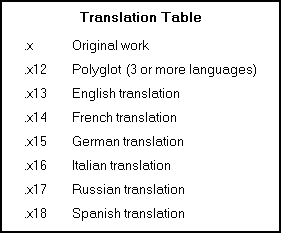Cataloger's Reference Shelf
Subject Cataloging Manual: Shelflisting
G 150 Translations (General)
BACKGROUND: A translation is a rendering from one language into another, or from an older form of a language into a modern form, more or less closely following the original. A translation can be identified in a bibliographic record by the presence of a uniform title with the addition of a language or languages at the end. The Library of Congress uses a Translation Table when assigning Cutter numbers for a translation. Translations generally follow the original work in alphabetical order by language. Prior to 1983, if there was an indication that the work was a translation either in the statement of responsibility in the body of the entry, or the cataloger indicated that a uniform title was not available, the Translation Table was applied. This practice was discontinued in 1983. This instruction provides guidelines for properly assigning Cutter numbers of translations.

1. General rule
Use the Translation Table when assigning a Cutter number for a translation only when a uniform title plus language(s) is provided and when the main entry is a personal author or title. Distinguish translations from the original work by using the Cutter of the original work modified by the application of the Translation Table.
Do not use the Translation Table:
![]() for entries with a corporate or conference heading (cf. G 220, section 1.b.)
for entries with a corporate or conference heading (cf. G 220, section 1.b.)
![]() for autobiographies or correspondence
for autobiographies or correspondence
![]() when using the Biography Table, except for the .xA6-Z area (cf. G 320)
when using the Biography Table, except for the .xA6-Z area (cf. G 320)
![]() when a caption includes the instructions "By date," unless a subarrangement is explicitly printed in the schedules.
when a caption includes the instructions "By date," unless a subarrangement is explicitly printed in the schedules.
2. Two languages
If two languages are named in the uniform title, Cutter for the first language.
3. Languages not listed
If a language is not listed on the Translation Table, select a number for that language that would agree alphabetically with the table and any translation(s) previously shelflisted in the same class. For example, if a German translation is already shelflisted on .x15, a Hebrew translation could be .x16, Portuguese .x17, etc.
Example:
|
DS117 |
|
|
.D8215 |
Dubnov, Semen Markovich, 1860-1941. |
|
1925 |
[Vsemirnaia istoriia evreiskogo naroda. German] |
|
|
Weltgeschichte des judischen volkes, von ... 1925. |
|
|
|
|
DS117 |
|
|
.D8216 |
Dubnov, Semen Markovich, 1860-1941. |
|
1958 |
[Vsemirnaia istoriia evreiskogo naroda. Hebrew] |
|
<Hebr> |
Divre yeme'am'olam. 1958. |
4. Earlier practice
If the number one (1) was omitted from the number representing the translation (e.g., .x for the original work, .x3 for an English translation, .x4 for French, .x5 for German, etc.), continue this practice only when the pattern has already been established for that work. Use the Translation Table without the number one (1).
5. By language, A-Z
When the caption By language, A-Z appears in the classification schedules, do not apply the Translation Table. Instead, Cutter for the language itself, e.g. .E5 for English, .F7 for French, .G4 for German, etc.
Example:
|
Dungan |
.D86 |
|
Dusus |
.D87 |
6. Serials
If a translation of a serial is classed in the same number as the serial in the original language, use successive Cutters to arrange the translations in alphabetical order by language.
To return: